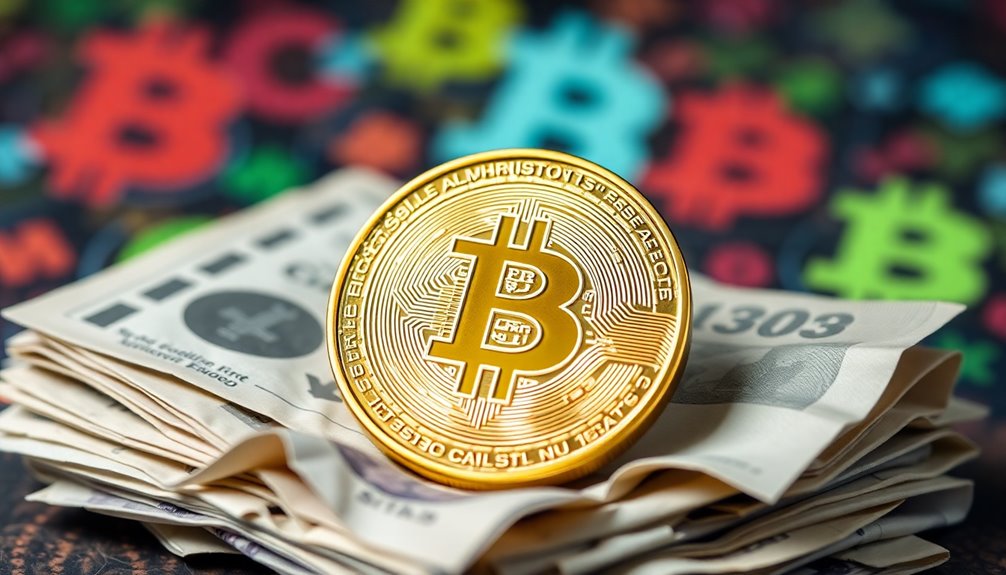Stop orders and stop-limit orders both help you manage trading risks, but they operate differently. When you set a stop order, it converts to a market order once the stop price is reached, guaranteeing execution but not the price. In contrast, a stop-limit order triggers a limit order at the stop price, giving you control over the execution price but risking non-execution if the price hits your limit. Choosing between them depends on whether you value execution assurance or price control. If you're curious about how these orders impact your strategies, there's more to explore.
Key Takeaways
- A stop order converts to a market order when the stop price is hit, ensuring execution without guaranteeing the price.
- A stop-limit order triggers a limit order at the stop price, allowing for price control but risking non-execution.
- Stop orders are preferable in volatile markets for guaranteed execution, while stop-limit orders provide better control over execution prices.
- Slippage can occur with stop orders, potentially executing at worse prices than intended due to market fluctuations.
- The choice between these orders depends on the trader's risk tolerance and the desired balance between execution assurance and price control.
Order Types Overview
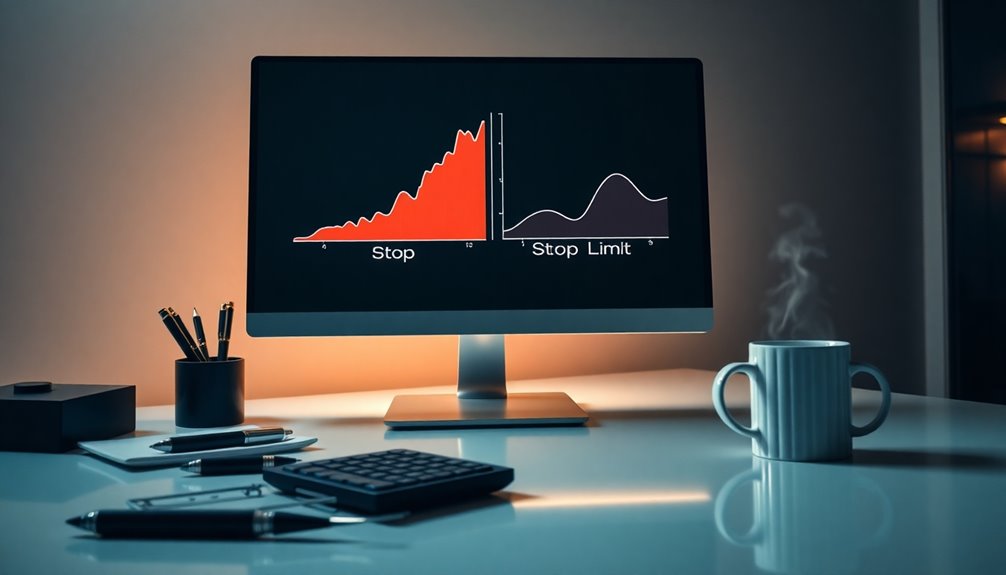
When navigating the world of trading, understanding the order types is crucial for effective decision-making.
A stop order triggers a market order to buy or sell once a specified stop price is hit, ensuring immediate execution but with no guarantee on the execution price.
In contrast, a stop-limit order combines a stop order with a limit order, activating a limit order when the stop price is reached. This gives you control over the execution price but carries the risk of non-execution if the limit isn't met.
Both orders play pivotal roles in risk management and should align with your trading strategies.
Assessing market fluctuations and price thresholds will help you choose wisely between stop and stop-limit orders.
Defining Stop Orders Clearly

Understanding the differences between order types sets the stage for grasping stop orders clearly.
A stop order triggers a market order to buy or sell a security once a specified stop price is reached. This guarantees execution but doesn't ensure the execution price.
In contrast, a stop-limit order activates a limit order once the stop price is hit, allowing for price control with a predefined limit price. However, it risks non-execution if limit conditions aren't met.
Traders often use stop orders to limit losses or protect gains in volatile markets, ensuring positions close when a specific price is reached.
Ultimately, the choice between these orders hinges on your need for execution assurance versus price control.
Order Execution Mechanics Explained
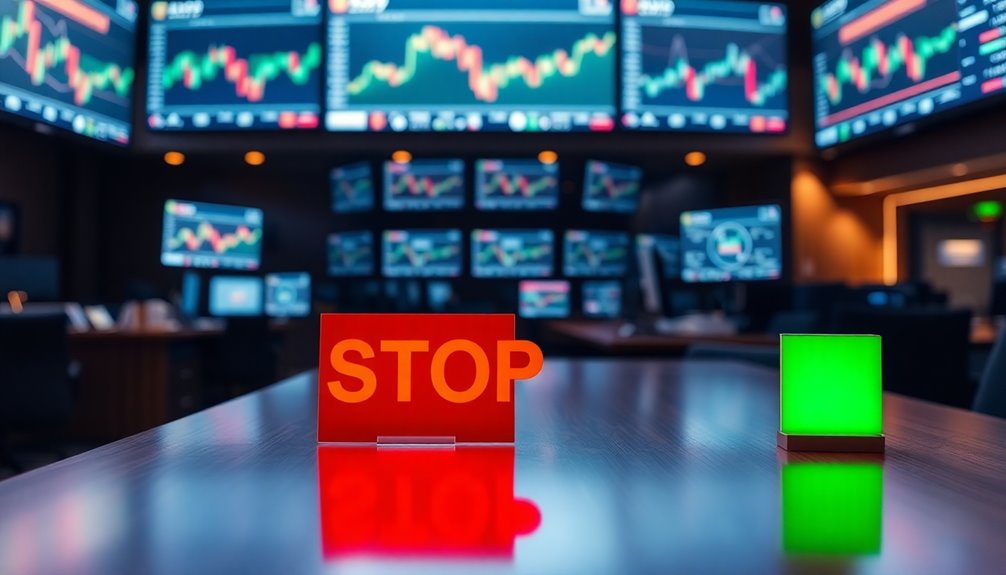
Order execution mechanics play a crucial role in how your trades are processed in the market, impacting the outcome of your investment strategies.
A stop order converts to a market order once the specified stop price is reached, ensuring execution, but there's no guarantee on the execution price.
In contrast, a stop-limit order triggers a limit order at the stop price, giving you more control over the execution price, but it may not execute if the market price doesn't meet the limit price.
While stop orders protect against losses, they can lead to slippage in volatile conditions.
Stop-limit orders can prevent execution altogether, impacting your trading strategies and potentially causing missed opportunities.
Pros and Cons Summary

Navigating the pros and cons of stop and stop-limit orders is essential for effective trading.
Stop orders offer execution assurance, triggering a market order once the stop price is reached. However, in volatile market conditions, this can lead to significant price fluctuations and potential slippage.
On the other hand, stop-limit orders provide more control over the execution price, but they carry the risk of non-execution if the market price jumps beyond your limit, resulting in missed opportunities.
Ultimately, your choice between these order types hinges on your trading strategy and risk management preferences.
Consider how much execution certainty you need versus your tolerance for price changes when deciding which order to use.
Stop vs. Stop-Limit Execution

When deciding between stop and stop-limit execution, it's crucial to recognize how each type functions in the market. A stop order triggers a market order once the stop price is reached, ensuring execution but lacking a specific execution price. This can lead to slippage, especially in volatile market conditions.
On the other hand, a stop-limit order activates a limit order at the stop price, allowing you greater price control, but it comes with the risk of non-execution if the limit price isn't met. For example, if you set a stop at $25 with a limit of $24.50, your order will only fill at $24.50 or better, which mightn't happen in fast-moving markets.
Market Volatility Impact
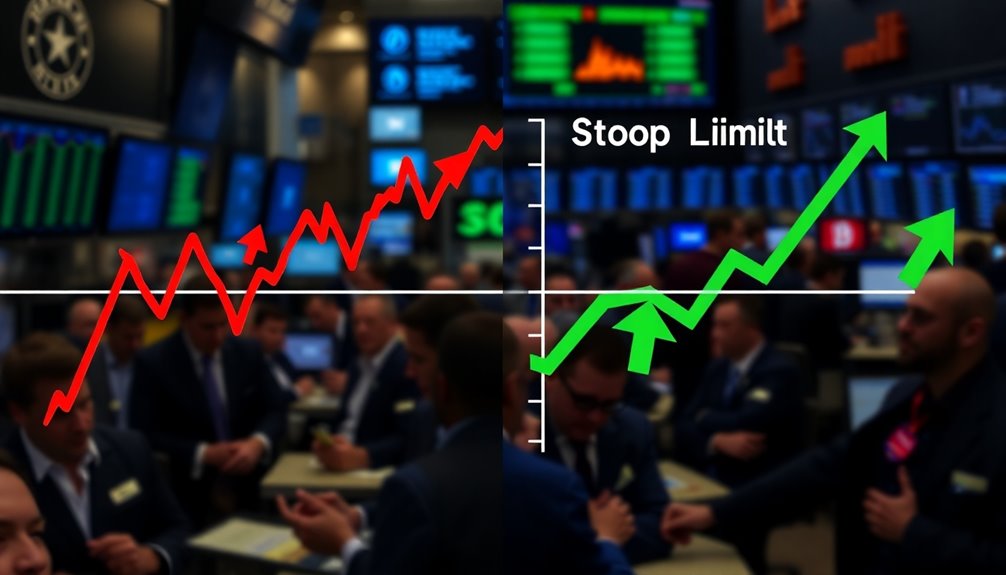
Market volatility significantly affects how stop and stop-limit orders execute, influencing your trading strategy.
In highly volatile markets, stop orders can lead to slippage, resulting in execution prices much lower than your intended stop price. This can seriously impact your returns.
On the other hand, stop-limit orders provide a limit price, which can protect you from unfavorable executions but may also lead to non-execution if the market quickly surpasses your set limit.
Price gaps often occur during market fluctuations, making stop orders more vulnerable to unexpected pricing.
It's vital to assess your risk tolerance when choosing between these orders, as the potential for non-execution with stop-limit orders can leave you exposed during rapid market movements.
Algorithmic Trading Influence
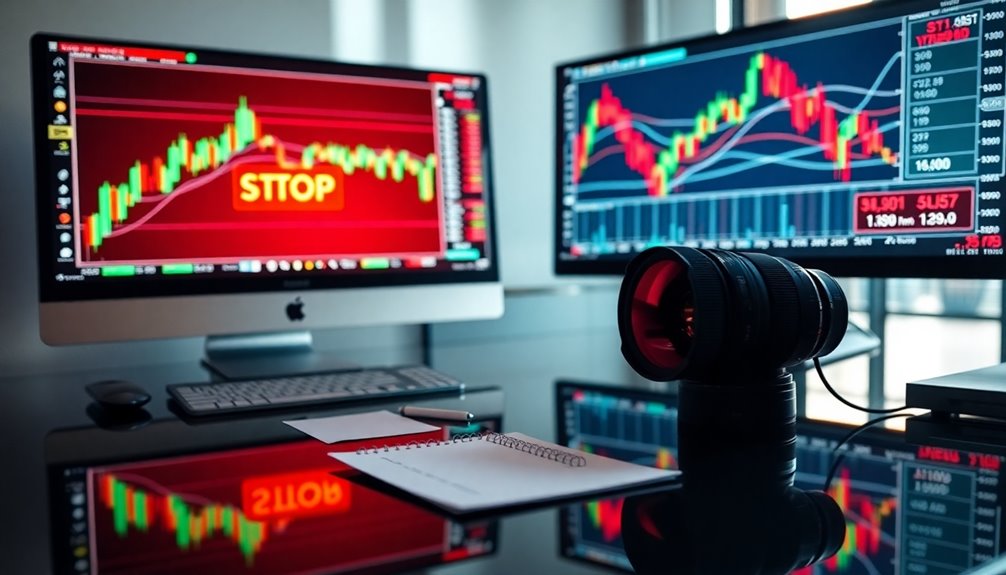
As algorithmic trading gains traction, understanding how it influences the use of stop and stop-limit orders becomes crucial for traders.
Algorithmic trading often employs stop orders for immediate market execution when a stop price is reached, which is vital during market volatility. In contrast, stop-limit orders allow you to maintain better price control, triggering a limit order only after the stop price is met. This can help reduce slippage in fast-moving markets.
Moreover, algorithms can adjust these order levels dynamically based on market conditions, enhancing your risk management strategies. By utilizing both order types, you can effectively balance timely execution with desired price control, ultimately optimizing your trading performance.
Use Trailing Stop Orders

Understanding the mechanics of trailing stop orders can enhance your trading strategy, particularly in volatile markets. A trailing stop order locks in profits by allowing the stop price to adjust as the market price rises, maintaining a set distance from the highest price achieved.
Unlike traditional stop orders, trailing stops only move upward, which helps protect against downside risk. When the stock price reverses and hits the adjusted stop price, a market order triggers execution.
You can customize trailing stops in points or percentages, tailoring your risk management approach to fit your volatility tolerance. However, be aware that in fast-moving markets, execution at the stop price isn't guaranteed, so always stay vigilant.
Frequently Asked Questions
Which Is Better Stop or Stop Limit?
When deciding between stop and stop-limit orders, it really depends on your trading strategy and risk tolerance.
If you want immediate execution and don't mind potential slippage, a stop order might be better for you.
However, if you prefer to control the price at which your trade executes, a stop-limit order could be the way to go.
Consider your goals and market conditions to make the best choice for your trading needs.
What Is an Example of a Stop Limit?
A good example of a stop-limit order is when you own shares of a stock currently priced at $60.
You set a stop price at $55 and a limit price at $54. If the stock drops to $55, your order triggers, but it'll only execute if the price stays above $54.
This way, you maintain control over your selling price while still aiming to protect yourself from further losses.
What Are the Disadvantages of a Stop Limit Order?
When you use a stop-limit order, you can face several disadvantages.
First, it mightn't execute if the limit price isn't met after the stop price triggers, causing missed trading opportunities.
In volatile markets, prices can jump over your limit quickly, leaving your order unfilled.
You might also encounter partial fills, which means only some of your shares execute, increasing your risk and potentially leading to higher brokerage fees.
Can You Have a Stop and Limit Order at the Same Time?
Yes, you can place a stop order and a limit order simultaneously for the same security.
This strategy helps you manage risk while capturing specific price points. When the stop price is reached, your stop order can trigger a market order to sell, while your limit order sets the price you want to buy or sell at.
Just remember to monitor both orders closely, as market conditions can affect their execution.
Conclusion
In summary, understanding the difference between stop and stop-limit orders is crucial for effective trading. While stop orders activate a market order once a certain price is reached, stop-limit orders set a specific price for execution. Each type has its pros and cons, especially in volatile markets. By considering these factors and possibly utilizing trailing stop orders, you can enhance your trading strategy and better navigate the complexities of the market.

